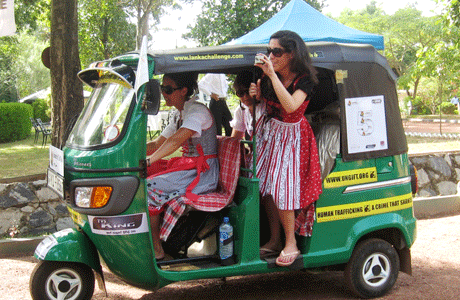Writing this with the overwhelming Sri Lankan victory yesterday against South Africa - The first test win after like one and half years. Increasingly the cricket updates in Twitter is becoming interesting and is a perfect way to keep updated on the match while you are on the move. Like my friend @Lishanw told me Twitter is a real fun way of following cricket because of all the hilarious comments.
Before i get in to the real call
What is Twitter?
Is a social network like Facebook (Second in popularity only to Facebook) based on text updates of 140 characters (Imagine a public SMS system). For more watch this video on Youtube.
What is a hashtag in Twitter?
The # symbol, called a hashtag, is used to mark keywords or topics in a Tweet. It was created organically by Twitter users as a way to categorize messages. Read
How you can track a match in Twitter is by following the match hashtag usually with the format countryVcountry. For e.g. #AUSvIND for Australia vs India or #SAvSL for South Africa vs. Sri Lanka.
There are two major confusions in Cricket hastags -
1. Which country first
The problem arises when one countires' cricket fans put their country code first and the other country does the other way.
For e.g. Pakistanis tweet #PAKvIND and Indians Tweet #INDvPAK, The Sri Lankans (Always trying to make a balance between the two) tweet with both #PAKvIND & #INDvPAK so both countries fans will read. This happens in every country in every match.
For this I recommend going in Alphabetical order. No matter how big
2. Just "V" or "VS"
Other confusion is whether to use VS or only V between the two country codes. For e.g. Some tweet #SAvSL while some tweet with #SAvsSL. Here I recommend using only one V, since it saves a character and time typing another letter S.
According to the above - The final hashtags to be used will be (Please ignore page formatting)
But we need to find a way to communicate this standards to all Cricket fans. Please comment below with your ideas.
Before i get in to the real call
What is Twitter?
Is a social network like Facebook (Second in popularity only to Facebook) based on text updates of 140 characters (Imagine a public SMS system). For more watch this video on Youtube.
What is a hashtag in Twitter?
The # symbol, called a hashtag, is used to mark keywords or topics in a Tweet. It was created organically by Twitter users as a way to categorize messages. Read
How you can track a match in Twitter is by following the match hashtag usually with the format countryVcountry. For e.g. #AUSvIND for Australia vs India or #SAvSL for South Africa vs. Sri Lanka.
There are two major confusions in Cricket hastags -
1. Which country first
The problem arises when one countires' cricket fans put their country code first and the other country does the other way.
For e.g. Pakistanis tweet #PAKvIND and Indians Tweet #INDvPAK, The Sri Lankans (Always trying to make a balance between the two) tweet with both #PAKvIND & #INDvPAK so both countries fans will read. This happens in every country in every match.
For this I recommend going in Alphabetical order. No matter how big
2. Just "V" or "VS"
Other confusion is whether to use VS or only V between the two country codes. For e.g. Some tweet #SAvSL while some tweet with #SAvsSL. Here I recommend using only one V, since it saves a character and time typing another letter S.
According to the above - The final hashtags to be used will be (Please ignore page formatting)
| Country | Australia | Bangladesh | England | India | New Zealand | Pakistan | South Africa | Sri Lanka | West Indies | Zimbabwe |
| Australia | AUSvBAN | AUSvENG | AUSvIND | AUSvNZ | AUSvPAK | AUSvSA | AUSvSL | AUSvWI | AUSvZIM | |
| Bangladesh | AUSvBAN | BANvENG | BANvIND | BANvNZ | BANvPAK | BANvSA | BANvSL | BANvWI | BANvZIM | |
| England | AUSvENG | BANvENG | ENGvIND | ENGvNZ | ENGvPAK | ENGvSA | ENGvSL | ENGvWI | ENGvZIM | |
| India | AUSvIND | BANvIND | ENGvIND | INDvNZ | INDvPAK | INDvSA | INDvSL | INDvWI | INDvZIM | |
| New Zealand | AUSvNZ | BANvNZ | ENGvNZ | INDvNZ | NZvPAK | NZvSA | NZvSL | NZvWI | NZvZIM | |
| Pakistan | AUSvPAK | BANvPAK | ENGvPAK | INDvPAK | NZvPAK | PAKvSA | PAKvSL | PAKvWI | PAKvZIM | |
| South Africa | AUSvSA | BANvSA | ENGvSA | INDvSA | NZvSA | PAKvSA | SAvSL | SAvWI | SAvZIM | |
| Sri Lanka | AUSvSL | BANvSL | ENGvSL | INDvSL | NZvSL | PAKvSL | SAvSL | SLvWI | SLvZIM | |
| West Indies | AUSvWI | BANvWI | ENGvWI | INDvWI | NZvWI | PAKvWI | SAvWI | SLvWI | WIvZIM | |
| Zimbabwe | AUSvZIM | BANvZIM | ENGvZIM | INDvZIM | NZvZIM | PAKvZIM | SAvZIM | SLvZIM | WIvZIM |
But we need to find a way to communicate this standards to all Cricket fans. Please comment below with your ideas.




